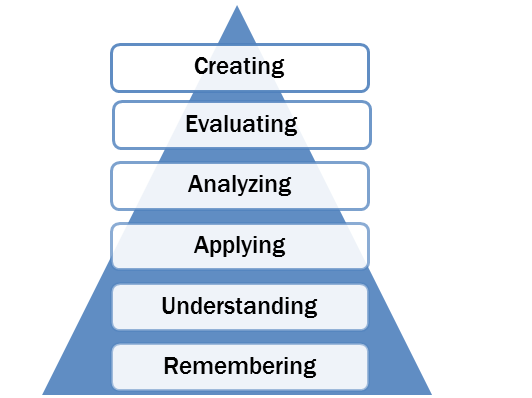Triangles can be exceptionally good at showing hierarchies, and Bloom's Taxonomy is one of the best. Developed in 1956 by a group of educational psychologists headed by Benjamin Bloom and revised by others in 2001, Bloom's Taxonomy names and describes learning goals. Each is a cognitive skill that builds on the level(s) below it:

At the top of the taxonomy rests Creating, an ability to invent or craft something that previously did not exist. That "something" might be an article, a revision of a manufacturing or decision-making process, a new perspective on an old problem. It might be a menu, a design for a doghouse, a plan for holiday decorating or a summer vacation. It might even be a presentation.
Important to know and to act upon is that creativity exists in each of us. Exercising it increases and strengthens it.
How do you do that? Try some of these methods—in both your personal and professional lives.
Clean the coffee pot or empty the dishwasher. Pull some weeds. Sharpen pencils. Such menial tasks make space in your mind for new ideas; note them as they occur. This technique may be especially helpful when you find yourself stuck in a logical loop or when you seem unable to find a way into a presentation or one of its sections.
Write as quickly as you can on a topic for 10-15 minutes without stopping. Don't correct grammar or sentence structure. Just write. If, for example, you're trying to work out the major messages in a report, begin by writing something like, "In this report I want . . ." and then continue by writing anything that occurs to you.
Chances are good that by the end of a 15-minute burst, you'll have the ideas and solutions that previously stymied you. This method stimulates creativity in part by silencing your inner critic, the one that often reminds you that your ideas are not right, suitable, or workable and so stops their flow.
This technique asks you to draw a bubble or circle in the center of a piece of paper, write an idea or topic within the circle, and then draw connecting bubbles to aspects or perspectives you associate with that idea or topic.
Working on an introduction of a keynote speaker? Write her name in a circle and then free-associate. Some of the connecting circles will likely name factual but somewhat mundane elements of her biography. But others will hold novel, unusual aspects—a story she's told, a seldom-mentioned achievement of which she’s proud, ways she spends her time and effort. You can use the resulting map to choose the elements that help you create a lively, interesting introduction.
4. CHANGE TOOLS OR ENVIRONMENT
Do you usually write using your computer? Occasionally switch to a legal pad or notebook and a pencil. Or to your phone or iPad. Try recording your thoughts rather than writing them; such a change often captures original ideas and approaches zipping so quickly through your mind that writing cannot capture them.
A change in environment can also free your creative abilities. Work on a project in a coffee shop or cafeteria, backyard or balcony, instead of at your desk. Take a walk. Look out a window and daydream. The novelty of a new environment or tool removes you from what you've become accustomed to, exposing you to unfamiliar stimuli that open fresh possibilities in your mind.
Add creativity to the habits of your mind; cultivate it. Practice it. The four tips above provide a good start, a focused beginning for moving creativity toward the peak of your cognitive taxonomy.




